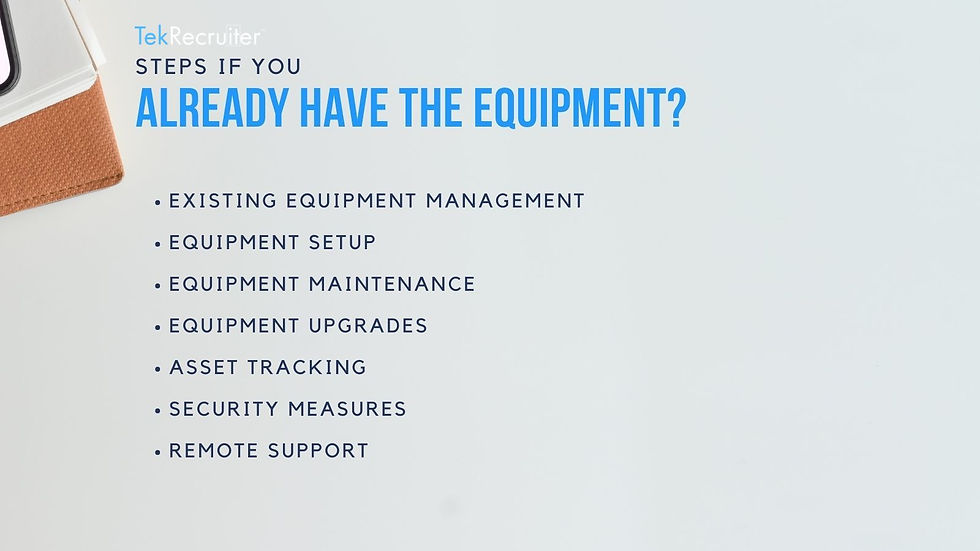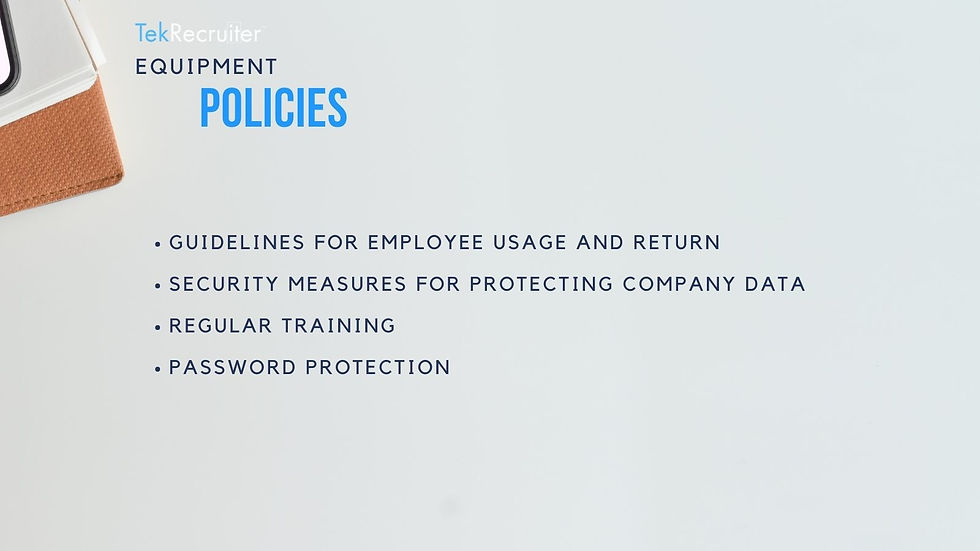What is the best way to provide equipment to my nearshore tech team?
- Ron Smith
- Sep 29, 2023
- 7 min read

It is important to provide your nearshore tech team with the necessary equipment and tools to ensure they can effectively perform their tasks. This not only includes shipping laptops, desktops, and mobile devices but also software licenses, peripherals (e.g. keyboards, mice), and other necessary hardware.
In this blog post let's explore the best ways to provide equipment to your nearshore tech team and ensure they have everything they need to succeed in your software development project.
Choose the Right Equipment

When deciding on what equipment to provide, there are several approaches you can take to supply your software development team:
Assess Equipment Needs:
Start by evaluating the specific equipment requirements of your nearshore software development team. Consider factors like hardware (e.g., laptops, desktops, monitors), software licenses, peripherals (e.g., keyboards, mice), and any specialized tools or equipment they may need for their work in nearshore development.
Research Suppliers:
Look for reliable suppliers who specialize in nearshore software development equipment. Consider both local vendors and international vendors with a track record of delivering quality products and services. Check customer reviews and ratings to show quality service and ensure their reputation.
Obtain Quotes and Compare Prices:
Reach out to selected suppliers and request quotes for the equipment you need for nearshore software development. Compare prices, warranties, and after-sales technical support offered by different suppliers to make an informed decision. Consider factors like international shipping costs and import duties if sourcing equipment internationally.
Consider Leasing or Renting:
Depending on your budget and requirements, consider leasing or renting equipment for your nearshore team for software development. This can be cost effective and provide flexibility and cost savings in outsourcing software development, especially for short-term projects this way you avoid shipping multiple laptops to your nearshore development team.
Plan for Shipping and Logistics:
If sourcing electronic devices from another location, plan for international shipping, and logistics. Coordinate with the supplier to ensure timely delivery and arrange for customs clearance. Consider shipping insurance to protect against loss or damage during transit, and consult shipping companies for specific information when shipping internationally.
Set Up Remote IT Support:
Ensure that your nearshore software development team has access to remote IT support. Establish communication channels with remote employees and protocols for reporting and resolving technical issues with software developers using the nearshore outsourcing and equipment.
Thorough Testing and Effective Use:
Once the equipment arrives, conduct thorough testing to ensure everything is in working order. Provide clear instructions or training materials to your nearshore software development team for effective use of the equipment.
Check the country's legal system and regulations
As your nearshore tech team may be located in a different country, it is important to familiarize yourself with the laws, customs charges and regulations of that country in relation to technology and equipment. Make sure you are compliant with any import or export regulations for bringing in or taking out equipment from other countries, as well as any data protection laws that may affect the handling of sensitive information.
Additionally, be aware of any tax laws, customs fees, shipping fees or tariffs that may impact the cost and maintenance of your equipment. Engage with a legal team or experts to ensure you are following all necessary regulations and avoiding any additional shipping fees or charges when shipping laptops internationally.
Maintaining open communication with your nearshore team about their equipment needs and providing support as needed can also help your nearshore teams navigate any challenges in managing equipment from afar.
What if I already have the equipment?

Many companies already possess the necessary equipment that they intend to dispatch to their employees. If that is the case and you already have the equipment, here are some additional steps you can take:
Existing Equipment Management:
Create an inventory list of all the equipment you already have. Include details such as item descriptions, serial numbers, and current condition allowing you to keep track of your inventory.
Equipment Setup:
Set up the equipment according to your team's requirements. This may involve installing necessary software, configuring network access, and ensuring that all peripherals are connected and functional.
Equipment Maintenance:
Implement a regular maintenance schedule to keep the equipment in good working condition. This may include cleaning the devices, updating software, and performing routine checks for any issues or malfunctions.
Equipment Upgrades:
Stay informed about the latest technology trends and advancements in your industry. Evaluate if any of your existing equipment needs upgrades or replacements to keep up with the evolving needs of your tech team. Consider factors such as performance, security, and compatibility with your software development needs.
Asset Tracking:
Implement an asset tracking system to monitor the usage and movement of your equipment. This can help prevent loss or theft and ensure that the equipment is being allocated efficiently among team members.
Security Measures:
Implement appropriate security measures to protect your equipment and sensitive data. This may include using encryption, antivirus software, regular backups, and enforcing strong access controls.
Remote Support:
Ensure that your nearshore tech team has access to remote IT support in case they encounter any technical issues with the equipment. Establish communication channels and protocols for reporting and resolving technical problems.
By following these steps, you can effectively manage and utilize the equipment you already have for your nearshore tech team, ensuring that it remains in good working condition and meets their needs.
Best practices to follow when shipping laptops internationally
Shipping a laptop internationally, particularly for company use, requires careful planning to ensure it arrives securely and in excellent condition. Below are some recommended practices for shipping a laptop to Latin America:
1. Use a reputable shipping carrier:
Choose a well-known and reliable shipping carrier with a proven track record in international shipments. FedEx, UPS, DHL, and reputable local carriers in the destination country are usually good options.
2. Insure the package:
Consider purchasing shipping insurance to cover the laptop's value in case of loss, damage, or theft during transit.
3. Proper packaging:
Use a sturdy, well-padded box that is appropriately sized for the laptop and any accompanying accessories. Ensure there is enough cushioning, such as bubble wrap or foam, to protect the laptop from shocks or bumps during transit.
4. Antistatic bags:
Place the laptop inside an antistatic bag to safeguard it against static electricity.
5. Labeling and documentation:
Clearly label the package with the recipient's name, address, and contact information, including a phone number. Include a return address in case of delivery issues. Fill out any required customs forms accurately, providing a detailed description of the laptop and its value.
6. Declare value accurately:
Properly declare the laptop's value on the customs forms. This is crucial for insurance purposes and compliance with import regulations.
7. Consider import restrictions and taxes:
Be aware of any import restrictions or taxes that may apply to laptops in the destination country. Obtain this information from the country's customs authority.
8. Choose a suitable shipping service level:
Select a shipping service level that aligns with your company's requirements in terms of cost, speed, and tracking capabilities.
9. Tracking and confirmation:
Opt for a shipping service that offers tracking information and share the details with the recipient for monitoring the shipment's progress.
10. Insurance and proof of delivery:
Retain copies of all shipping documents, including the shipping receipt, tracking information, and proof of delivery, if available.
11. Coordinate with the recipient:
Notify the recipient about the shipment and provide them with the tracking information. Confirm their availability to receive the package.
12. Follow-up:
After the laptop has been delivered, follow up with the recipient to ensure it arrived in good condition.
What happens if the employee leaves the company?

When a candidate resigns from your nearshore tech team, the handling of the equipment they were using typically depends on your organization's policies and agreements. Here are some common scenarios:
Return of Equipment:
If the equipment was provided by the company, it is usually expected that the resigning candidate returns the equipment before their departure. This ensures that the company retains ownership and can redistribute the equipment to other team members or repurpose it as needed.
Transfer to Another Team Member:
In some cases, if another team member requires the same type of equipment and it is available, the equipment may be transferred to them. This can be done after ensuring that any necessary data or personal information has been properly removed from the device.
Purchase by the Employee:
Depending on the circumstances and agreement between the employee and the company, the resigning candidate may have the option to purchase the equipment they were using at a fair market value. This allows them to continue using the equipment personally or in their new role.
Reuse or Reallocation:
If the resigning candidate was using their own personal equipment, there may be no need for immediate action. The equipment can be reused or reallocated within the organization based on its condition and compatibility with other team members' needs.
Wiping Data and Resetting Devices:
In all cases, regardless of who owns the equipment, it is important to ensure that all sensitive company data and personal information are securely wiped from the devices before they are reassigned or returned. This helps maintain data privacy and security.
It's crucial to establish clear guidelines and protocols regarding equipment usage and return when employees join the company. This ensures a smooth transition and minimizes potential issues when a candidate resigns and equipment needs to be handled appropriately. Regularly reviewing and updating these policies can also help keep up with changes in technology, employee productivity and company needs.
Additionally, having a tracking system for equipment can make the process more efficient. This can include keeping records of which employee is assigned to which equipment, its condition, and any repairs or upgrades done. This information can be useful when evaluating costs and determining if new equipment may be needed.
Furthermore, companies can also consider offering employees the option to purchase their assigned equipment at a discounted price upon resignation instead of shipping laptops internationally. This not only provides an incentive for employees to take care of their equipment but also reduces the burden on the company to manage and dispose of outdated equipment.
Equipment Policies

As technology continues to advance, it is important for companies to also stay updated with their equipment policies. This includes not only guidelines for employee usage and return, but also security measures for protecting company data during the software development process.
With the increasing use of remote work and personal devices, companies should consider implementing measures such as password protection, encryption, and remote wiping capabilities to safeguard sensitive information. Regular training and updates on these policies can also help ensure that employees are aware of their responsibilities in keeping company equipment secure.
Additionally, it is important for companies to have a clear understanding of any legal requirements and regulations surrounding data security and the handling of employee equipment, especially in industries with strict data privacy laws.
Ensure your employee success

As outsourcing strategy and the recruitment of tech talent from neighboring countries, continues to grow in popularity, it is crucial to grasp the importance of equipping your team and outsourcing partners with the necessary tools to accomplish their work successfully.
By implementing strong policies, providing necessary training and support, and handling equipment retrieval with sensitivity, companies and remote teams can effectively protect their equipment and data while still allowing for the flexibility of remote work. It is also important for companies to regularly review and update their policies as technology and working practices for remote employees continue to evolve.
When selecting your next employee, it's crucial to collaborate with a reputable recruiting company that specializes in nearshore software development outsourcing. They will assist you throughout the entire hiring process, - from identifying the ideal candidate to seamlessly onboarding them and assisting in shipping laptops internationally. At TekRecruiter we always make sure to help our clients every step of the way, ensuring a seamless collaboration successful remote work experience for both the employee and the employer in the software development process.



Comments